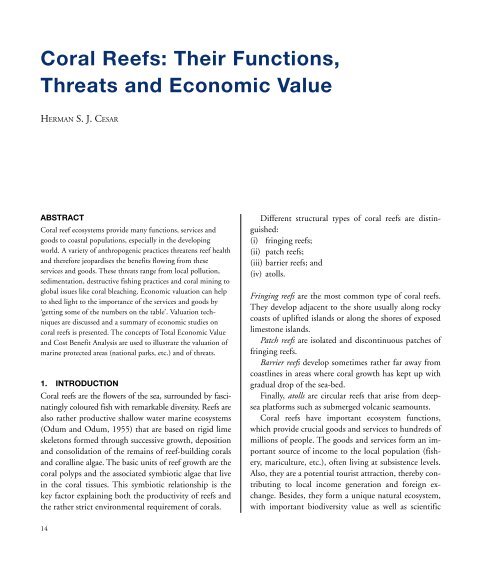You also want an ePaper? Increase the reach of your titles
YUMPU automatically turns print PDFs into web optimized ePapers that Google loves.
<strong>Coral</strong> <strong>Reefs</strong>: Their Functions,<br />
Threats and Economic Value<br />
HERMAN S. J. CESAR<br />
ABSTRACT<br />
<strong>Coral</strong> reef ecosystems provide many functions, services and<br />
goods to coastal populations, especially in the developing<br />
world. A variety <strong>of</strong> anthropogenic practices threatens reef health<br />
and therefore jeopardises the benefits flowing from these<br />
services and goods. These threats range from local pollution,<br />
sedimentation, destructive fishing practices and coral mining to<br />
global issues like coral bleaching. Economic valuation can help<br />
to shed light to the importance <strong>of</strong> the services and goods by<br />
‘getting some <strong>of</strong> the numbers on the table’. Valuation techniques<br />
are discussed and a summary <strong>of</strong> economic studies on<br />
coral reefs is presented. The concepts <strong>of</strong> Total Economic Value<br />
and Cost Benefit Analysis are used to illustrate the valuation <strong>of</strong><br />
marine protected areas (national parks, etc.) and <strong>of</strong> threats.<br />
1. INTRODUCTION<br />
<strong>Coral</strong> reefs are the flowers <strong>of</strong> the sea, surrounded by fascinatingly<br />
coloured fish with remarkable diversity. <strong>Reefs</strong> are<br />
also rather productive shallow water marine ecosystems<br />
(Odum and Odum, 1955) that are based on rigid lime<br />
skeletons formed through successive growth, deposition<br />
and consolidation <strong>of</strong> the remains <strong>of</strong> reef-building corals<br />
and coralline algae. The basic units <strong>of</strong> reef growth are the<br />
coral polyps and the associated symbiotic algae that live<br />
in the coral tissues. This symbiotic relationship is the<br />
key factor explaining both the productivity <strong>of</strong> reefs and<br />
the rather strict environmental requirement <strong>of</strong> corals.<br />
Different structural types <strong>of</strong> coral reefs are distinguished:<br />
(i) fringing reefs;<br />
(ii) patch reefs;<br />
(iii) barrier reefs; and<br />
(iv) atolls.<br />
Fringing reefs are the most common type <strong>of</strong> coral reefs.<br />
They develop adjacent to the shore usually along rocky<br />
coasts <strong>of</strong> uplifted islands or along the shores <strong>of</strong> exposed<br />
limestone islands.<br />
Patch reefs are isolated and discontinuous patches <strong>of</strong><br />
fringing reefs.<br />
Barrier reefs develop sometimes rather far away from<br />
coastlines in areas where coral growth has kept up with<br />
gradual drop <strong>of</strong> the sea-bed.<br />
Finally, atolls are circular reefs that arise from deepsea<br />
platforms such as submerged volcanic seamounts.<br />
<strong>Coral</strong> reefs have important ecosystem functions,<br />
which provide crucial goods and services to hundreds <strong>of</strong><br />
millions <strong>of</strong> people. The goods and services form an important<br />
source <strong>of</strong> income to the local population (fishery,<br />
mariculture, etc.), <strong>of</strong>ten living at subsistence levels.<br />
Also, they are a potential tourist attraction, thereby contributing<br />
to local income generation and foreign exchange.<br />
Besides, they form a unique natural ecosystem,<br />
with important biodiversity value as well as scientific<br />
14


















